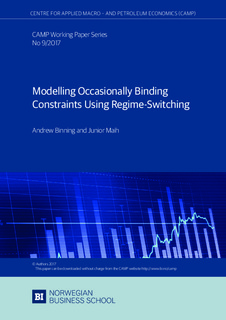| dc.contributor.author | Binning, Andrew | |
| dc.contributor.author | Maih, Junior | |
| dc.date.accessioned | 2018-01-04T11:00:07Z | |
| dc.date.available | 2018-01-04T11:00:07Z | |
| dc.date.issued | 2017-12 | |
| dc.identifier.issn | 1892-2198 | |
| dc.identifier.uri | http://hdl.handle.net/11250/2475574 | |
| dc.description.abstract | Occasionally binding constraints are part of the economic landscape: for instance recent experience with the global financial crisis has highlighted the gravity of the lower bound constraint on interest rates; mortgagors are subject to more stringent borrowing conditions when credit growth has been excessive or there is a downturn in the economy. In this paper we take four common examples of occasionally binding constraints in economics and demonstrate how to use regime-switching to incorporate them into DSGE models. In particular we investigate the zero lower bound constraint on interest rates, occasionally binding collateral constraints, downward nominal wage rigidities and irreversible investment. We compare our approach against some well-known methods for solving occasionally-binding constraints. We demonstrate the versatility of our regime-switching approach by combining multiple occasionally binding constraints to a model solved using higher-order perturbation methods, a feat that is di cult to achieve using alternative methodologies. | nb_NO |
| dc.language.iso | eng | nb_NO |
| dc.publisher | BI Norwegian Business School, Centre for Applied Macro- and Petroleum Economics | nb_NO |
| dc.relation.ispartofseries | CAMP Working Paper Series;9 | |
| dc.subject | Occasionally Binding Constraints | nb_NO |
| dc.subject | DSGE models | nb_NO |
| dc.subject | ZLB | nb_NO |
| dc.subject | collateral constraints | nb_NO |
| dc.title | Modelling Occasionally Binding Constraints Using Regime-Switching | nb_NO |
| dc.type | Working paper | nb_NO |
| dc.source.pagenumber | 90 | nb_NO |
